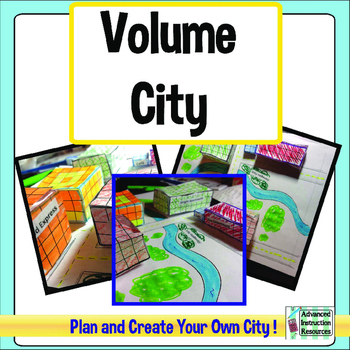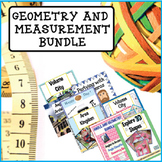Volume City - Build a city while using measurement and geometry skills!
- Zip
What educators are saying
Also included in
- Are you looking for something to help your classroom learn about geometry and measurement concepts? If so, I have a bundle for you! This bundle includes best sellers at a HUGE discount. I’ve used every resource in this bundle in my own classroom. Seriously! These projects and activities are perfPrice $40.00Original Price $73.00Save $33.00
Description
This resource is perfect to teach volume, perimeter and area. In this math project based learning activity, students use area, perimeter, and volume to design their own city. This product is designed to encourage students to become architects and create their own city. Students will create a draft, make rectangular nets, build prisms and place them on a map. While the students are creating, they're also learning important math concepts that will help them throughout life! You can find examples of the projects by visiting #VolumeCity.
What's included:
This activity includes a teacher presentation that can be given to students, clear directions, student examples, a city planning project dimension sheet, map template, centimeter grid paper and rubric.
A secondary city template is also included. The second city includes nets of pyramids, cylinders and triangular prisms.
This activity will encourage students to create their own city and learn about math at the same time. Students will discover how rectangular prisms are constructed and place them in appropriate places.
Students will also explore how grids can help identify the length, width, and height of rectangular prisms. By using trial and error, as well as perseverance skills, students will find the volume of each building and create a city that is only limited by their imagination.
====================================================
This resource also includes two additional products: Representing Volume and Rectangular Prisms and Volume. These are two activities that can help students prepare for creating their own Volume City. Specifically, Rectangular Prisms and Volume will prepare students to construct their own prisms by providing examples of different nets. I've seen this used at the upper elementary and middle school levels. Students can complete this independently or in groups.
Students will:
1.) Use centimeter grids to draw nets for 3D shapes that match a certain volume criteria
2.) Cut out the nets and construct an assigned 3D shape
3.) Use a formula to find the volume of a cylinder, prism, cone, or pyramid
4.) Use number models that represent the volume formula
5.) Display the 3D shape in a miniature classroom city
====================================================
See what others are saying ...
★★★★ "This has been a fun challenge for my 5th graders. Helping them create their own nets has been engaging and thought-provoking. A fun activity for my higher kids, and a challenge for my lower kids.."
★★★★ "I love how this product comes with different options for different skill sets. Great product! Thank you!"
★★★★ "I used this to teach volume last year and the kids LOVED it. I even ended up using it again as an "end of the year" activity. This is some of the best $5 you will ever spend! It is realistic and really allows the kiddos to get creative. Great work. My students loved this! They had such a great time, they added lots more buildings and learned how to find the volume too!"
★★★★ "My fifth graders loved creating their own cities. This was a great way to assess their abilities to find volumes of rectangular prisms without having a test. Especially during parcc season!"
====================================================
➽ Please download preview for more information.
➽ HERE is a blog that shows completed projects and the phases.
➽ HERE is a video preview.
➽ A rubric and two performance tasks are provided.
Key words: volume, measurement, area, perimeter, square units, stem resource, student projects, science, math
---------------------------------------------------------------------------------------------------






